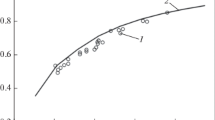Abstract
The article deals with matters concerned with the problem of determining the statistical characteristics of variable parameters (the variation range and distribution law) in analyzing the uncertainty and sensitivity of calculation results to uncertainty in input data. A comparative analysis of modern approaches to uncertainty in input data is presented. The need to develop an alternative method for estimating the uncertainty of model parameters used in thermal–hydraulic computer codes, in particular, in the closing correlations of the loop thermal hydraulics block, is shown. Such a method shall feature the minimal degree of subjectivism and must be based on objective quantitative assessment criteria. The method includes three sequential stages: selecting experimental data satisfying the specified criteria, identifying the key closing correlation using a sensitivity analysis, and carrying out case calculations followed by statistical processing of the results. By using the method, one can estimate the uncertainty range of a variable parameter and establish its distribution law in the above-mentioned range provided that the experimental information is sufficiently representative. Practical application of the method is demonstrated taking as an example the problem of estimating the uncertainty of a parameter appearing in the model describing transition to post-burnout heat transfer that is used in the thermal–hydraulic computer code KORSAR. The performed study revealed the need to narrow the previously established uncertainty range of this parameter and to replace the uniform distribution law in the above-mentioned range by the Gaussian distribution law. The proposed method can be applied to different thermal–hydraulic computer codes. In some cases, application of the method can make it possible to achieve a smaller degree of conservatism in the expert estimates of uncertainties pertinent to the model parameters used in computer codes.
Similar content being viewed by others
References
V. G. Asmolov, V. N. Blinkov, V. I. Melikhov, O. I. Melikhov, Yu. V. Parfenov, D. A. Emel’yanov, A. E. Kiselev, and K. S. Dolganov, “Modern state and development trends of system thermal–hydraulic codes abroad,” Teplofiz. Vys. Temp. 52 (1), 105–117 (2014).
D. A. Afremov, Yu. V. Zhuravleva, Yu. V. Mironov, V. S. Nazarov, V. E. Radkevich, and D. A. Yashnikov, “Analyzing the uncertainty in calculations of loss of coolant accidents for the Kursk NPP Unit 1,” At. Energiya 98 (6), 422–428 (2005).
G. L. Ponomarenko, M. A. Bykov, and A. M. Moskalev, “Using the BEPU method for studying beyond-design emergency operating modes of a VVER-1000 reactor involving cooldown,” VANT, Ser. Obesp. Bezopasn. AES, Issue 25, 78–95 (2009).
Yu. N. Kuznetsov, Heat Transfer in the Nuclear Reactor Safety Problem (Energoatomizdat, Moscow, 1989) [in Russian].
H. Glaeser, “GRS method for uncertainty and sensitivity evaluation of code results and applications,” Sci. and Technol. of Nucl. Instal. (2008). http://dx.doi.org/ 10.1155/2008/798901.
A. N. Rumyantsev, “The quantile uncertainty assessment method,” At. Energiya 102 (4), 208–216 (2007).
D. A. Yashnikov, Development and Application of a Procedure for Analyzing the Uncertainty in Thermal–Hydraulic Calculations of RBMK Reactor Emergency Modes of Operation, Candidate’s Dissertation in Technical Sciences (NIKIET, Moscow, 2013).
V. A. Vasilenko, Yu. A. Migrov, S. N. Volkova, Yu. V. Yudov, I. G. Danilov, V. G. Korotaev, V. V. Kut’in, B. R. Bondarchik, and D. V. Benediktov, “Experience in creating the thermohydraulic computer code of the new generation KORSAR and its main characteristics,” Therm. Eng. 49 (11), 888 (2002).
Yu. V. Yudov, S. N. Volkova, and Yu. A. Migrov, “The closing relationships of the thermohydraulic model of the KORSAR computer code,” Therm. Eng. 49 (11), 901 (2002).
O. V. Remizov, V. A. Vorob’ev, and V. V. Sergeev, Heat Transfer in a Post-Burnout Region: An Analytic Review OB-24 (FEI, Obninsk, 1976) [in Russian].
A. A. Veremeev, A. A. Ivashkevich, I. P. Smogalev, V. N. Vinogradov, A. D. Efanov, and V. V. Sergeev, “Verifying the post-burnout heat-transfer model of the thermohydraulic code KORSAR,” Therm. Eng. 49 (11), 948 (2002).
A. V. Vladimirov, V. S. Granovskii, A. N. Gudoshnikov, I. G. Danilov, D. N. Donchenko, V. G. Korotaev, and Yu. A. Migrov, “Analyzing uncertainties in numerically simulating the emergency operating modes of VVER reactors using the PANDA/KORSAR software system,” in Proceedings of the Interdepartmental Seminar“Thermal Physics2008,” Obninsk, October 15–17, 2008
P. V. Novitskii and I. A. Zograf, Evaluation of Measurement Errors (Energoatomizdat, Leningrad, 1991) [in Russian].
V. E. Gmurman, Probability Theory and Mathematical Statistics: A Handbook for Higher Schools (Vysshaya Shkola, Moscow, 2003) [in Russian].
Author information
Authors and Affiliations
Corresponding author
Additional information
Original Russian Text © A.S. Gricay, Yu.A. Migrov, 2015, published in Teploenergetika.
Rights and permissions
About this article
Cite this article
Gricay, A.S., Migrov, Y.A. Assessment of uncertainties of the models used in thermal–hydraulic computer codes. Therm. Eng. 62, 656–662 (2015). https://doi.org/10.1134/S0040601515090049
Published:
Issue Date:
DOI: https://doi.org/10.1134/S0040601515090049




